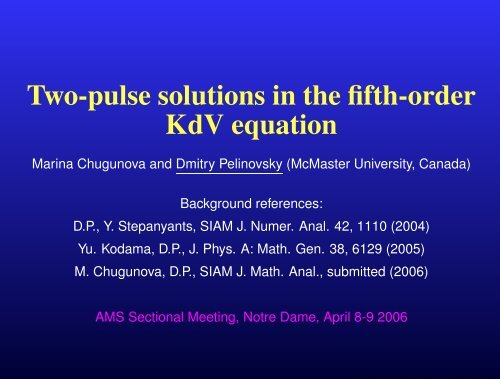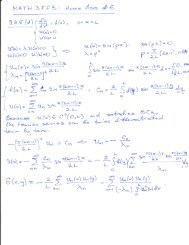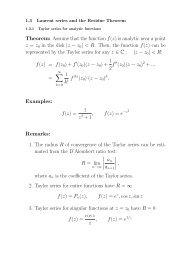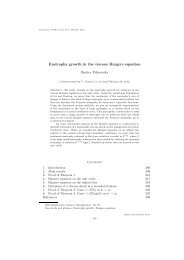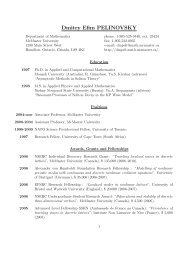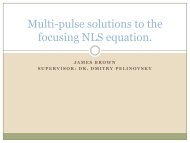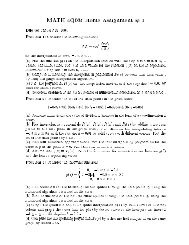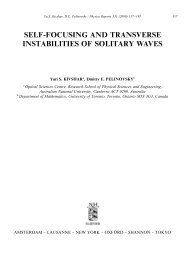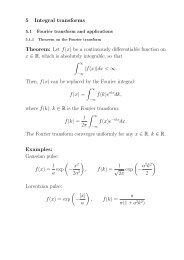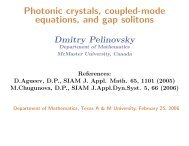Two-pulse solutions in the fifth-order KdV equation - Dmitry ...
Two-pulse solutions in the fifth-order KdV equation - Dmitry ...
Two-pulse solutions in the fifth-order KdV equation - Dmitry ...
Create successful ePaper yourself
Turn your PDF publications into a flip-book with our unique Google optimized e-Paper software.
<strong>Two</strong>-<strong>pulse</strong> <strong>solutions</strong> <strong>in</strong> <strong>the</strong> <strong>fifth</strong>-<strong>order</strong><br />
<strong>KdV</strong> <strong>equation</strong><br />
Mar<strong>in</strong>a Chugunova and <strong>Dmitry</strong> Pel<strong>in</strong>ovsky (McMaster University, Canada)<br />
Background references:<br />
D.P., Y. Stepanyants, SIAM J. Numer. Anal. 42, 1110 (2004)<br />
Yu. Kodama, D.P., J. Phys. A: Math. Gen. 38, 6129 (2005)<br />
M. Chugunova, D.P., SIAM J. Math. Anal., submitted (2006)<br />
AMS Sectional Meet<strong>in</strong>g, Notre Dame, April 8-9 2006
Background and motivations<br />
Fifth-<strong>order</strong> <strong>KdV</strong> <strong>equation</strong><br />
u t + u xxx − u xxxxx + 2uu x = 0<br />
has travel<strong>in</strong>g wave <strong>solutions</strong> u = φ(z), z = x − ct, where φ(z)<br />
solves <strong>the</strong> fourth-<strong>order</strong> ODE<br />
φ (iv) − φ ′′ + cφ = φ 2 .
Background and motivations<br />
Fifth-<strong>order</strong> <strong>KdV</strong> <strong>equation</strong><br />
u t + u xxx − u xxxxx + 2uu x = 0<br />
has travel<strong>in</strong>g wave <strong>solutions</strong> u = φ(z), z = x − ct, where φ(z)<br />
solves <strong>the</strong> fourth-<strong>order</strong> ODE<br />
φ (iv) − φ ′′ + cφ = φ 2 .<br />
Applications:<br />
• capillary-gravity water waves (Craig–Groves, 1994)<br />
• cha<strong>in</strong>s of coupled oscillators (Gorshkov–Ostrovsky, 1979)<br />
• magneto–acoustic waves <strong>in</strong> plasma (Kawahara, 1972)
Solitary waves<br />
Stability of <strong>the</strong> critical po<strong>in</strong>t (0, 0, 0, 0) <strong>in</strong> <strong>the</strong> fourth-<strong>order</strong> ODE:<br />
φ ∼ e κz : κ 4 − κ 2 + c = 0.<br />
Existence of localized <strong>solutions</strong>:<br />
• c < 0 - no <strong>pulse</strong> <strong>solutions</strong> (Tovbis, 2000; Lombardi, 2000)<br />
• 0 < c < 1 - unique one-<strong>pulse</strong> solution (Amick–Toland, 1992;<br />
4<br />
Groves, 1998)<br />
• c > 1 - unique one-<strong>pulse</strong> and <strong>in</strong>f<strong>in</strong>ite countable set of two-<strong>pulse</strong><br />
4<br />
<strong>solutions</strong> (Buffoni–Sere, 1996)<br />
⇒ The doma<strong>in</strong> of our studies is c > 1 4 .
Ma<strong>the</strong>matical problems<br />
Numerical approximations of two-<strong>pulse</strong> <strong>solutions</strong><br />
• numerical shoot<strong>in</strong>g method and cont<strong>in</strong>uation techniques<br />
(Champneys, 1993)<br />
• iterations <strong>in</strong> Fourier space (Petviashvili’s method)<br />
⇒ Iterations diverge for two-<strong>pulse</strong> <strong>solutions</strong>!
Ma<strong>the</strong>matical problems<br />
Numerical approximations of two-<strong>pulse</strong> <strong>solutions</strong><br />
• numerical shoot<strong>in</strong>g method and cont<strong>in</strong>uation techniques<br />
(Champneys, 1993)<br />
• iterations <strong>in</strong> Fourier space (Petviashvili’s method)<br />
⇒ Iterations diverge for two-<strong>pulse</strong> <strong>solutions</strong>!<br />
Spectral stability of two-<strong>pulse</strong> <strong>solutions</strong><br />
• Lyapunov–Schmidt reductions (Sandstede, 1998)<br />
• Count of eigenvalues <strong>in</strong> Pontryag<strong>in</strong> space (Kre<strong>in</strong>’s signatures)<br />
⇒ The count of eigenvalues is <strong>in</strong>conclusive for two-<strong>pulse</strong> <strong>solutions</strong>!
Petviashvili’s method<br />
ODE for solitary waves<br />
φ (iv) − φ ′′ + cφ = φ 2 ,<br />
z ∈ R<br />
The ODE becomes <strong>the</strong> fixed-po<strong>in</strong>t problem <strong>in</strong> H 2 (R):<br />
ˆφ(k) =<br />
̂φ 2 (k)<br />
(c + k 2 + k 4 ) , k ∈ R<br />
where c > 0 and ˆφ(k) is <strong>the</strong> Fourier transform of φ(z).<br />
Iterations {û n (k)} ∞ n=0 are def<strong>in</strong>ed recursively <strong>in</strong> H 2 ev(R):<br />
û n+1 (k) = M 2 n<br />
û 2 n(k)<br />
(c + k 2 + k 4 ) , M[û n] =<br />
∫<br />
R (c + k2 + k 4 ) [û n (k)] 2 dk<br />
∫<br />
R ûn(k)û2 n(k)dk
Convergence Theorem<br />
• Let ˆφ(k) be a solution of <strong>the</strong> fixed-po<strong>in</strong>t problem <strong>in</strong> H 2 ev(R)<br />
• Let H be <strong>the</strong> Jacobian operator of <strong>the</strong> ODE at φ(z):<br />
H = c − ∂ 2 z + ∂ 4 z − 2φ(z)<br />
Theorem: If H has exactly one negative eigenvalue and a simple<br />
zero eigenvalue and if<br />
∣ ∣∣∣<br />
ei<strong>the</strong>r φ(z) ≥ 0 or<br />
∣ <strong>in</strong>f φ(z) < c<br />
z∈R 2 ,<br />
<strong>the</strong>n <strong>the</strong>re exists an open neighborhood of ˆφ <strong>in</strong> H 2 ev(R), <strong>in</strong> which ˆφ<br />
is <strong>the</strong> unique fixed po<strong>in</strong>t and <strong>the</strong> sequence of iterations {û n (k)} ∞ n=0<br />
converges to ˆφ.
One-<strong>pulse</strong> <strong>solutions</strong><br />
Let φ ≡ Φ(z) be a one-<strong>pulse</strong> solution <strong>in</strong> H = c − ∂ 2 z + ∂ 4 z − 2Φ(z).<br />
Then, H has exactly one negative eigenvalue and a simple kernel<br />
with Φ ′ (z) <strong>in</strong> H 2 (R).
Analysis of convergence<br />
Numerical factors for numerical error:<br />
• truncation of z ∈ R to <strong>the</strong> <strong>in</strong>terval z ∈ [−d, d]<br />
• truncation of Fourier series by <strong>the</strong> discrete sum with N terms<br />
• small tolerance ε for E M = |M n − 1| and<br />
E ∞ = ‖u n+1 − u n ‖ L ∞
<strong>Two</strong>-<strong>pulse</strong> <strong>solutions</strong><br />
Let φ ≡ φ n (z) be a two-<strong>pulse</strong> solution. Then,<br />
φ(z) = Φ(z − s) + Φ(z + s) + ϕ(z),<br />
where ‖ϕ‖ L ∞ = O(e −2κs ) and |s − s n | = O(e −2κs ), where s n is an<br />
extremum po<strong>in</strong>t of W (2s) <strong>in</strong><br />
∫<br />
W = Φ 2 (z)Φ(z + 2s)dz.<br />
R
<strong>Two</strong>-<strong>pulse</strong> <strong>solutions</strong><br />
Let φ ≡ φ n (z) be a two-<strong>pulse</strong> solution. Then,<br />
φ(z) = Φ(z − s) + Φ(z + s) + ϕ(z),<br />
where ‖ϕ‖ L ∞ = O(e −2κs ) and |s − s n | = O(e −2κs ), where s n is an<br />
extremum po<strong>in</strong>t of W (2s) <strong>in</strong><br />
∫<br />
W = Φ 2 (z)Φ(z + 2s)dz.<br />
R<br />
The operator H has two f<strong>in</strong>ite negative eigenvalues, a simple kernel<br />
with φ ′ n(z), and a small eigenvalue µ <strong>in</strong> H 2 (R), such that<br />
∣ µ + 2W ′′ (2s n )<br />
Q ∣ ≤ C ne −4κs n<br />
, Q = ‖Φ ′ ‖ 2 L > 0. 2
Iterations of <strong>the</strong> method<br />
<strong>Two</strong>-<strong>pulse</strong> <strong>solutions</strong>
<strong>Two</strong>-<strong>pulse</strong> <strong>solutions</strong><br />
Iterations of <strong>the</strong> method<br />
M<strong>in</strong>imum error for root search
Numerical algorithm<br />
Theorem: There exists s = s ∗ near s = s n such that <strong>the</strong> iteration<br />
method with u 0 = Φ(z − s) + Φ(z + s) converges to φ n (z) <strong>in</strong> a<br />
local neighborhood of φ n <strong>in</strong> H 2 ev(R).
Spectral stability<br />
L<strong>in</strong>earized problem for spectral stability<br />
∂ z Hv = λv,<br />
v ∈ L 2 (R)<br />
Eigenvalues with Re(λ) > 0 result <strong>in</strong> spectral <strong>in</strong>stability.<br />
Let φ ≡ φ n (z) be a two-<strong>pulse</strong> solution. There exists a pair of small<br />
eigenvalues λ of <strong>the</strong> l<strong>in</strong>earized operator ∂ z H, such that<br />
∣ λ2 + 4W ′′ (2s n )<br />
P ′ (c) ∣ ≤ C ne −4κs n<br />
, P ′ (c) = d dc ‖Φ‖2 L > 0. 2<br />
• W ′′ (2s n ) > 0 - pair of purely imag<strong>in</strong>ary eigenvalues<br />
• W ′′ (2s n ) < 0 - pair of real eigenvalues
Spectral stability <strong>the</strong>orem<br />
Notations:<br />
• N real - <strong>the</strong> number of real positive eigenvalues<br />
• N comp - <strong>the</strong> number of complex eigenvalues <strong>in</strong> <strong>the</strong> first open<br />
quadrant<br />
- <strong>the</strong> number of simple positive imag<strong>in</strong>ary eigenvalues<br />
with (Hv, v) ≤ 0<br />
• N −<br />
imag<br />
• The kernel of H is simple and P ′ (c) > 0
Spectral stability <strong>the</strong>orem<br />
Notations:<br />
• N real - <strong>the</strong> number of real positive eigenvalues<br />
• N comp - <strong>the</strong> number of complex eigenvalues <strong>in</strong> <strong>the</strong> first open<br />
quadrant<br />
- <strong>the</strong> number of simple positive imag<strong>in</strong>ary eigenvalues<br />
with (Hv, v) ≤ 0<br />
• N −<br />
imag<br />
• The kernel of H is simple and P ′ (c) > 0<br />
Theorem: Then,<br />
N real + 2N comp + 2N −<br />
imag<br />
= n(H) − 1,<br />
where n(H) is <strong>the</strong> number of negative eigenvalues of H.
Applications of <strong>the</strong> Theorem<br />
Counts of eigenvalues:<br />
• One-<strong>pulse</strong> <strong>solutions</strong><br />
n(H) = 1,<br />
N real = N comp = N −<br />
imag = 0<br />
The one-<strong>pulse</strong> solution is a ground state (Levandosky, 1999)
Applications of <strong>the</strong> Theorem<br />
Counts of eigenvalues:<br />
• One-<strong>pulse</strong> <strong>solutions</strong><br />
n(H) = 1,<br />
N real = N comp = N −<br />
imag = 0<br />
The one-<strong>pulse</strong> solution is a ground state (Levandosky, 1999)<br />
• <strong>Two</strong>-<strong>pulse</strong> <strong>solutions</strong> with W ′′ (2s n ) < 0<br />
n(H) = 2, N real = 1, N comp = N −<br />
imag = 0<br />
The two-<strong>pulse</strong> solution with W ′′ (2s n ) < 0 is spectrally<br />
unstable.
Applications of <strong>the</strong> Theorem<br />
Counts of eigenvalues:<br />
• <strong>Two</strong>-<strong>pulse</strong> <strong>solutions</strong> with W ′′ (2s n ) > 0<br />
n(H) = 3, N real = 0, N comp + N −<br />
imag = 1<br />
The "standard" count is <strong>in</strong>conclusive for <strong>the</strong>se <strong>solutions</strong>.
Applications of <strong>the</strong> Theorem<br />
Counts of eigenvalues:<br />
• <strong>Two</strong>-<strong>pulse</strong> <strong>solutions</strong> with W ′′ (2s n ) > 0<br />
n(H) = 3, N real = 0, N comp + N −<br />
imag = 1<br />
The "standard" count is <strong>in</strong>conclusive for <strong>the</strong>se <strong>solutions</strong>.<br />
Theorem: Let λ be a simple purely imag<strong>in</strong>ary eigenvalue of ∂ z H <strong>in</strong><br />
L 2 (R). Then, it is structurally stable to parameter cont<strong>in</strong>uation, i.e.<br />
it rema<strong>in</strong>s purely imag<strong>in</strong>ary eigenvalue upon an addition of a<br />
relatively compact perturbation to ∂ z H.<br />
N comp = 0,<br />
N −<br />
imag = 1<br />
The two-<strong>pulse</strong> solution with W ′′ (2s n ) > 0 is spectrally stable.
Numerical spectrum<br />
Exponentially weighted space<br />
H 2 α = { v ∈ H 2 loc(R) : e αz v(z) ∈ H 2 (R) }
Numerical spectrum<br />
Exponentially weighted space<br />
H 2 α = { v ∈ H 2 loc(R) : e αz v(z) ∈ H 2 (R) }
Numerical spectrum
Conclusions<br />
Outcomes of our work:<br />
• Application of Pontryag<strong>in</strong> spaces to <strong>KdV</strong> <strong>equation</strong>s<br />
• Numerical approximations of two-<strong>pulse</strong> <strong>solutions</strong><br />
• Proof of structural stability of embedded eigenvalues
Conclusions<br />
Outcomes of our work:<br />
• Application of Pontryag<strong>in</strong> spaces to <strong>KdV</strong> <strong>equation</strong>s<br />
• Numerical approximations of two-<strong>pulse</strong> <strong>solutions</strong><br />
• Proof of structural stability of embedded eigenvalues<br />
Open problems:<br />
• Error bounds on validity of <strong>the</strong> Newton’s particle law:<br />
P ′ (c)¨L = −W ′′ (L),<br />
where L(t) = 2s is <strong>the</strong> distance between two <strong>pulse</strong>s.<br />
• Numerical approximations of three- and multi-<strong>pulse</strong> <strong>solutions</strong><br />
• Proof of asymptotic stability of multi-<strong>pulse</strong> <strong>solutions</strong>
Software for relevant computations


